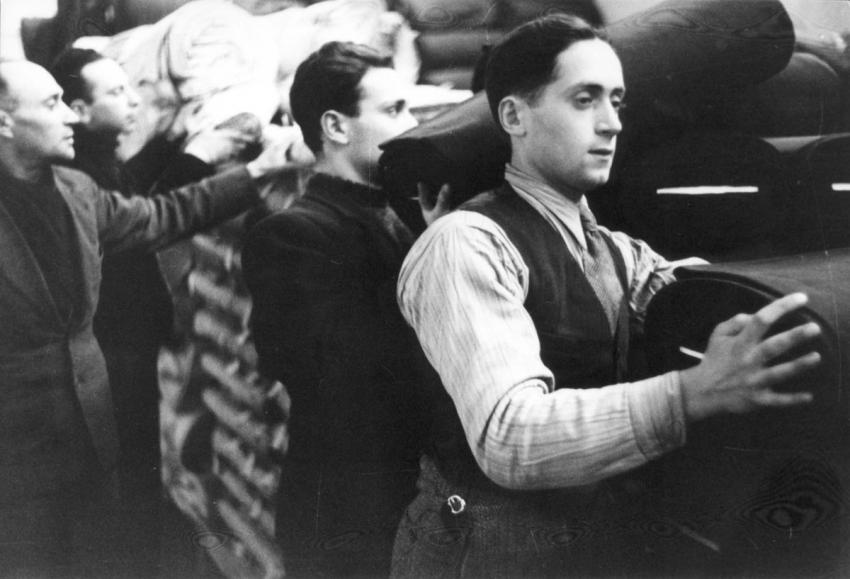The Lodz ghetto was sealed in April 1940, at which point, 164,000 Jews were incarcerated there. Gradually, more Jews were brought there from the surrounding areas, and then from central and western Europe, bringing the number of ghetto inhabitants to over 200,000. The Aeltestenrat (“Council of Elders”), the Jewish council in the ghetto, headed by Mordechai Chaim Rumkowski, established factories in the ghetto and organized the workforce to man them, and tried to drum up orders from the Germans. The factories were referred to by the Jews as "resorts". The Jewish council saw the establishment of factories in the ghetto as the only way of saving the incarcerated population from starvation. The starving Jews of the ghetto were prepared to work in return for extremely meager portions of food.
In May 1940, the first sewing "resort" was opened. 300 tailors worked there, who brought their sewing machines and work tables from home. The initial orders were few and small, and required the use of raw materials from the ghetto itself, as at first, the Germans did not supply the raw materials. In June 1940, Rumkowski wrote:
"I explained to the workers that if they work hard and well, orders will start to come in, and thousands of people will have work. I have excellent artisans in the ghetto."
In October 1940, the German ghetto administration headed by Hans Biebow, decided to assist in the establishment of production companies in the ghetto. As the number of satisfied customers increased, the orders grew. Due to poor working conditions and attempts to heat the "resorts" in the freezing winter of 1940-41, fires were not uncommon. The substandard work conditions and starvation rations distributed to the workers led to unrest and demonstrations, causing the Aeltestenrat to shut down the "resorts" temporarily. Rumkowski attempted to appease the discontented workers by approaching different political party representatives in the ghetto, who organized themselves to provide more food for their members, and the factories reopened.
On 8 February 1941, a newsletter preserved in the Chronicles of the Lodz Ghetto bore the headline: "Impressive Developments in the Labor Resorts", and declared that the ghetto was a major center for industrial and manual production, employing tailors, weavers, shoemakers, upholsterers, furriers, hatmakers, sock-knitters, slippers-makers, electricians, tanners, metalworkers and others.
"And yet this is not enough. These numbers will grow in the future… extensive development plans are anticipated, in the effort to locate and establish new branches of manufacture, and to significantly expand the old factories…"
Some 120 factories were set up in the ghetto, producing mostly textiles, and over 70,000 Jews worked there. In June 1944, when most of the ghetto population had died of starvation and disease, or been taken away in the 1942 deportations to the death camps, 77,000 Jews remained in the Lodz ghetto, some 90% of whom were employed in the factories. In the period June-August 1944, almost all the remaining Jews in the ghetto were deported to the Chelmno and Auschwitz death camps. The exact number of Lodz Jews who survived the camps is unknown, but it is estimated to be no higher than 7,000.
Yad Vashem Photo Archives, 7261/2 – Courtesy of the National German Archive (Bundesarchiv)







